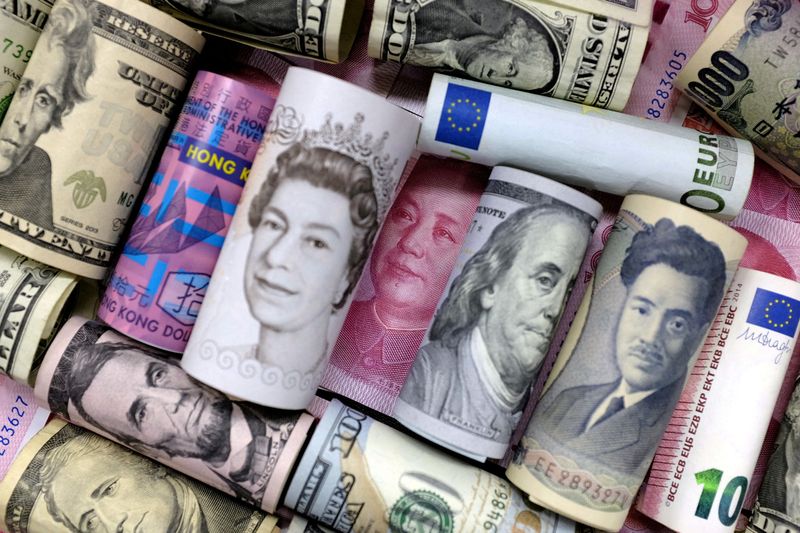By Jamie McGeever
ORLANDO, Florida (Reuters) -Asian countries probably don't want it and they certainly didn't cause it, but a 'beggar thy neighbor' wave of exchange rate depreciation may be about to hit the continent.
If not a full-blown currency war, then a series of skirmishes is looming as policymakers grapple with a resurgent U.S. dollar, a fragmented G10 central bank policy path, and a staggering slump in the Japanese yen which appears to have Tokyo's tacit approval.
There's a general consensus that a weaker exchange rate is no longer seen as the only lever countries can pull to boost economic growth, given how deep cross-border supply chains and manufacturing processes run today compared with decades gone by.
But old habits die hard, and it's difficult to avoid a situation where an outsized move in one of the region's major currencies - in this case the yen - doesn't put pressure on the others.
While countries may not be actively trying to export their way to prosperity, seismic terms of trade shifts in one tend not to go unmatched.
Exchange rates still matter, especially in Asia with its long history of intra-region export competitiveness. As the prospect of multiple U.S. interest rate cuts this year fades, Asia is feeling the squeeze from the all-powerful dollar.
"There are few emerging countries aiming for FX depreciation, but everyone is looking over their shoulder," says Steven Englander, head of G10 FX strategy at Standard Chartered (OTC:SCBFF).
"There is a limit to how much competitive disadvantage countries can take, even if they are not actively looking to gain advantage from currency moves," he adds.
JAPAN, CHINA SPILLOVERS
Many countries in Asia may be moving closer to those limits, effectively pushed there by some of their G10 peers.
Any commonality between G10 central banks that may have existed earlier this year on the 2024 interest rate outlook is fraying, cementing the dollar's position as investors' most favored currency.
On Tuesday afternoon Fed Chair Jerome Powell gave the clearest signal yet that the bar for rate cuts this year is rising, while that morning European Central Bank President Christine Lagarde said rates will probably be cut soon.
The Swiss National Bank has already broken ranks with the Fed, last month becoming the first G10 central bank to cut rates, while the Bank of Japan's absence from the FX market as the yen plummets is more conspicuous by the day.
The yen's weakness is a competitive advantage Asia's second- largest economy is getting that its regional rivals are not. A 25% depreciation over the last two years helped Japan avoid recession, contributing an estimated 1.4 percentage points to overall growth in fiscal 2023/24.
So far this year the yen is down 7% against the Chinese yuan and 9% against the U.S. dollar, the currencies of its two largest export markets. It is the weakest in over 30 years against both and near a 16-year low against South Korea's won.
For its part, even although China's yuan is its strongest in a year on a real effective exchange rate (REER) basis now, it is still within sight of last July's decade low.
CONNECTION
Beijing will want to ensure that any deterioration in bilateral U.S.-China trade amid rising Sino-U.S. tensions and the threat of increased tariffs and trade restrictions is made up for elsewhere, like Europe and other Asian countries.
Intra-regional trade was about 46% of Asia's total trade in 1990 and 53% in 2000, according to Oxford Economics. It now stands at around 60%, of which around two thirds is in intermediate goods, essentially inputs into other products.
This inter-connectedness dilutes the power of exchange rates in cross-border trade and masks the true nature of countries' trade links with one another.
For example, U.S. imports from China as a share of America's total imports fell 8% over the 2017-23 period, according to Oxford Economics, while the share of imports from Europe, Mexico Vietnam, Taiwan and Korea rose.
Over the same period, these countries - especially Vietnam - all saw imports from China as a share of total imports rise, suggesting Uncle Sam's trade exposure to China shifted to more indirect than direct.
Adam Slater, lead economist at Oxford Economics, is fairly sanguine that Asia will come through the current FX turbulence relatively unscathed.
"These periods of dollar strength create strains on the margins, but unless a country has serious underlying issues such as poorly managed and or poorly structured debt, they probably tend to be less dramatic than you think," he said.
A repeat of the late 1990s Asian FX fire storm is unlikely, but that doesn't mean competitive FX depreciations can be ruled out, especially with the dollar on a seemingly self-fulfilling spiral higher.
(The opinions expressed here are those of the author, a columnist for Reuters.)
(By Jamie McGeever; Editing by Andrea Ricci)
